

CarExpert.com.au
The CarExpert team's favourite cars of 2025
4 Days Ago
Worried about the new Defender? Don't be, it's fearsomely capable on and off the beaten path.
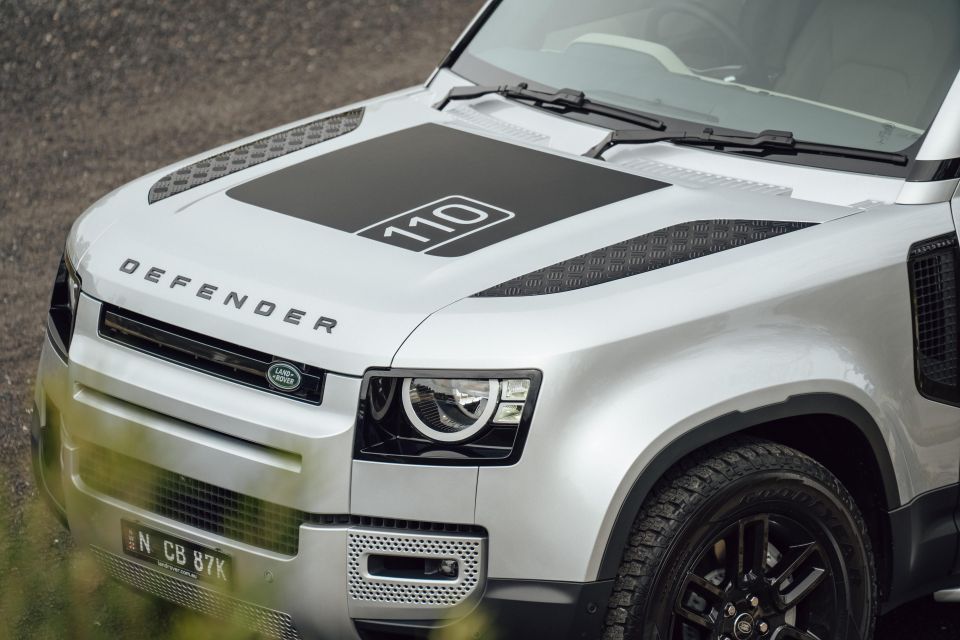
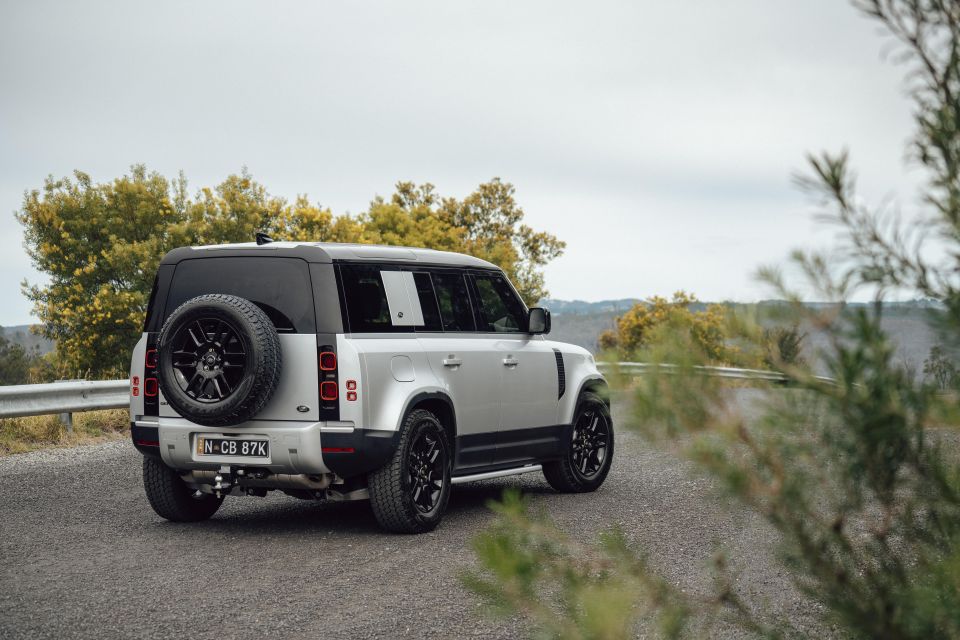

Senior Road Tester
New from
$137,100
excl. on-roads

Senior Road Tester
New from
$137,100
excl. on-roads


Senior Road Tester
New from
$137,100
excl. on-roads

Senior Road Tester
New from
$137,100
excl. on-roads
Quickly see how this car stacks up against its competition. Select any benchmark to see more details.
Where expert car reviews meet expert car buying – CarExpert gives you trusted advice, personalised service and real savings on your next new car.
Update: 2021 Land Rover Defender Review
Long before Range Rover and its myriad models, there was just the LandRover. It managed to survive in single-generation form for a staggering 68 years.
Remarkable stuff, but testament to its operational hardiness in more than 128 markets around the globe, plenty of them considered the most inhospitable on earth.
Which brings me to the all-new, second-generation Land Rover Defender – a 21 century born-again replacement, effectively 70 years in the making from some of the best SUV minds on the planet.
The new Defender is very different in every respect, but no less groundbreaking than its predecessor. It moves the game forward to a place none of its rivals have dared tread, except maybe the Mercedes-Benz G-Class, but even that can’t hold a candle to this thing.
It’s been on the drawing board (or is that the CAD screen?) for more than a decade. That’s how long Land Rover has had to get this new version right. I clearly recall Land Rover’s chief design officer, Gerry McGovern, sharing his vision for a family of Defenders to reach a far greater customer base than the narrow market the old one played in, icon status notwithstanding.

Even then, McGovern intimated it wasn’t going to be a restomod project, but an all-new design that would give a nod or two to the original design out of respect for what it had accomplished.
Coca-Cola bottle aside, you’d have to put the first-generation Land Rover up there as one of the most recognisable silhouettes in the world. One that is known from New York to Timbuktu, and everywhere in between.
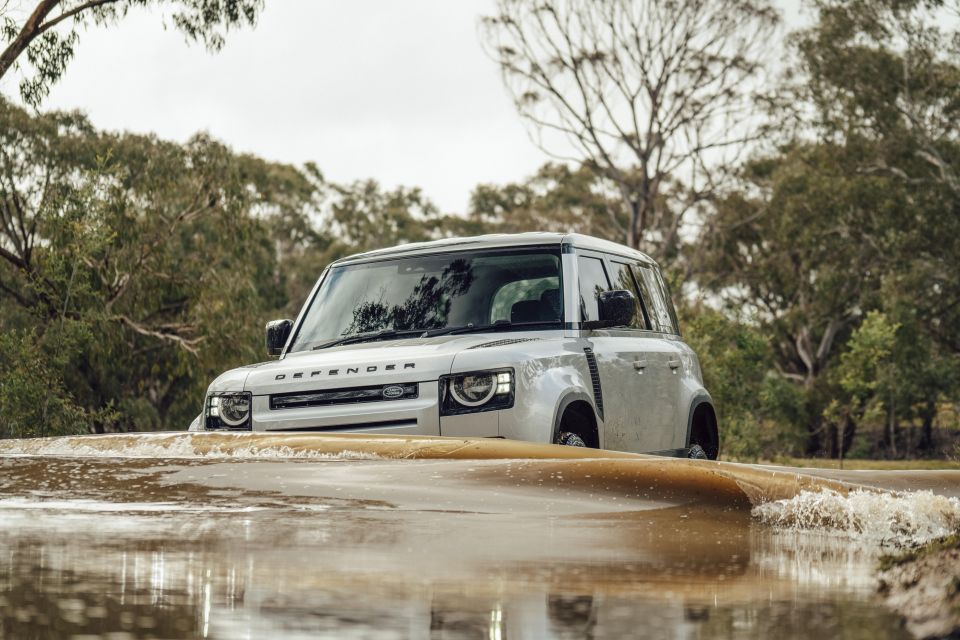
The side opening tailgate is a nice touch on the new model, as are the roof-mounted Alpine lights.
Seeing it up close and in the metal for the first time there’s a lot to take in. It’s a big unit, at more than five metres long including the boot-mounted spare tyre. It’s also more than two metres wide, and that’s with the chunky side mirrors folded.
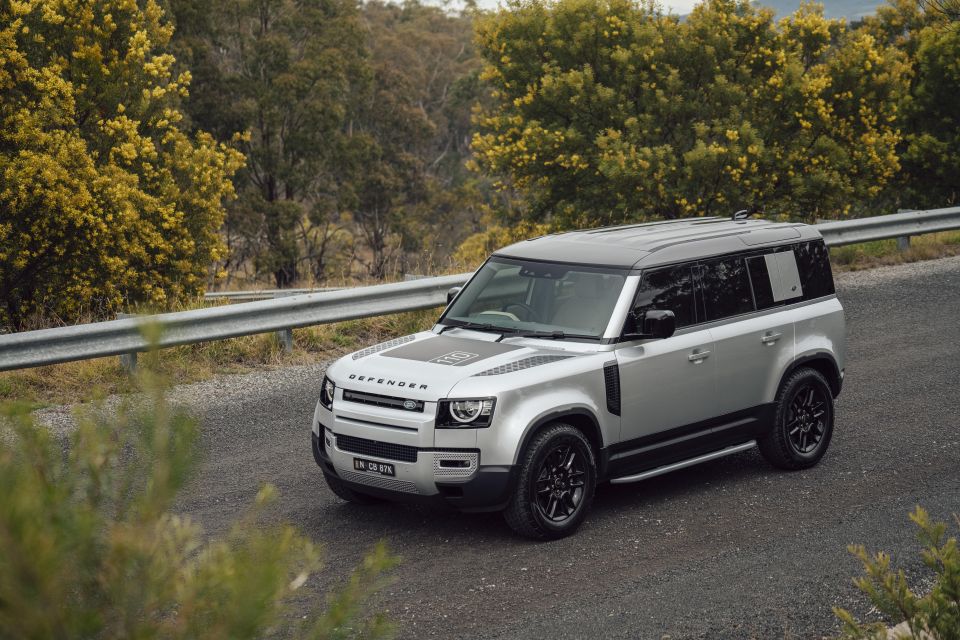
Size is one aspect, but it’s the level of intricate detail all over the new Defender that captivates me. I was lucky enough to see it for the first time at the 2019 Frankfurt motor show, where it was the star attraction but the crowds prevented proper examination of the finer forms.
The embossed rear lights – square, vertically set – are pure genius and unique in the automotive industry. It’s industrial art. The same goes for the miniature versions on the outside that double as reversing lights. Tucking in behind the lead vehicle on our 30km off-road course I was besotted by the light signature they provide.
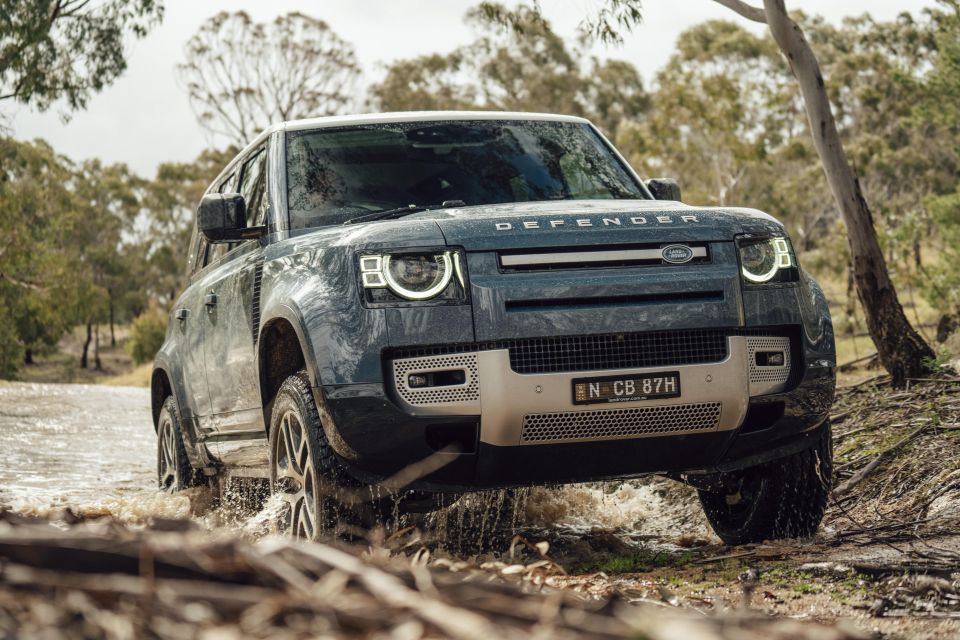
The same goes for the headlight assembly, recessed into rectangular housings for greater protection for hardcore bush work. The front LED fog lights are similarly treated and just as cool.
Questioning the new Defender’s off-road credentials? Don’t you worry. Underneath the bodywork is a variation of the D7 platform used in the Range Rover, Range Rover Sport, and Discovery, only for Defender it’s called the D7x (for extreme) thanks to serious new levels of strengthening to handle its wide-ranging talents.
To that effect, the new Defender doesn’t share a body panel with another Land Rover. It sits 20mm higher compared than the models listed above, and has short front and rear overhangs for impressive approach and departure angles. That’s another reason the spare is mounted on the tailgate.
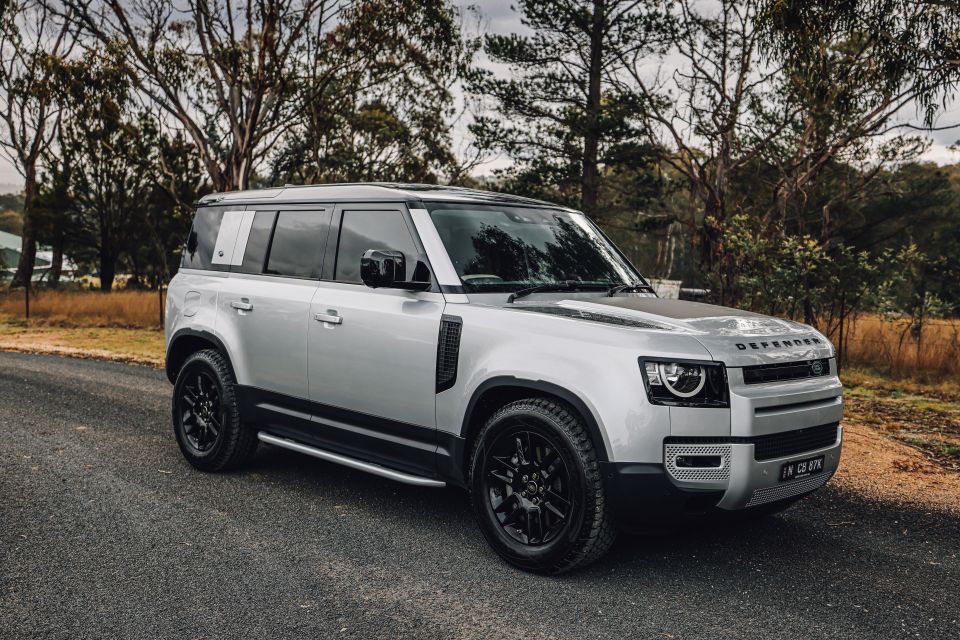
What about towing? I can hear the die-hard traditionalists having a dig as I type these words. It looks too good to be of any use for towing the boat. Try 3500kg braked, and a maximum tow ball weight of 350kg should answer any reservations.
Even the roof can handle a static load of 300kg or a dynamic load of 168kg. It’s quite extraordinary. Overkill? Maybe, but not for those who take up the optional expedition-ready pop-up roof tent.
Inside is just as spectacular as the exterior – this is where luxury blends with engineering porn. (That’s the exposed, powder-coated magnesium cross bar beam integral to the overall strength of the body architecture, by the way). It even has Defender stamped in front of the front passenger seat.
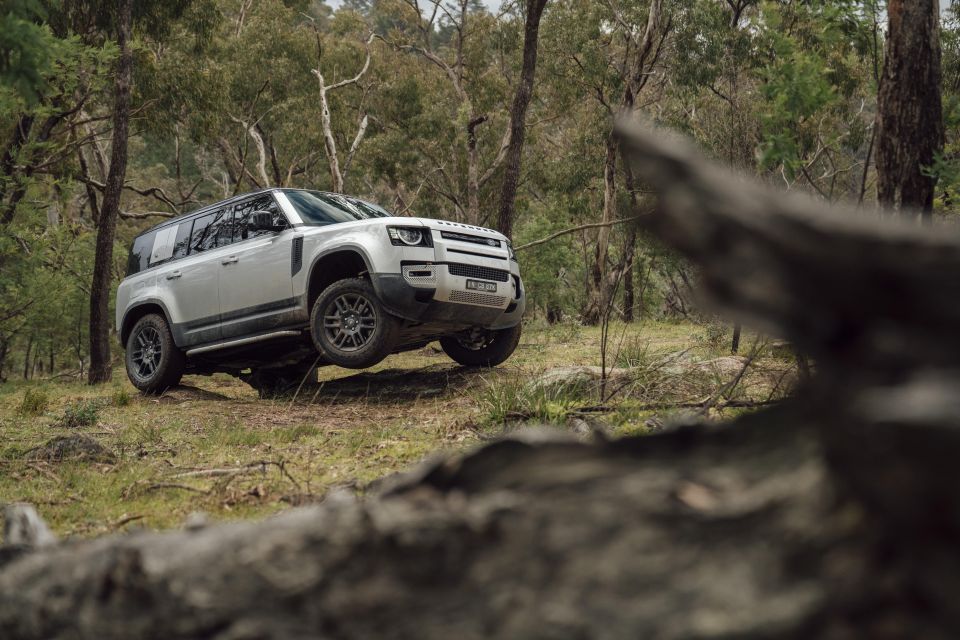
You’ll also find dozens of exposed Allen head screws around the cabin for more of that semi-industrial look. I can’t get enough of them.
You better get cracking if you like what you see, because the initial allocation of the two diesel models, the D200 and D240, are already sold out, which is why the choice of vehicle for the launch event was limited to the P400 MHEV with its inline-six petrol engine.
“Demand has been well ahead of expectations” according to Mark Cameron, Jaguar Land Rover managing director here in Australia. And after driving it on and off road, I don’t doubt it. This is a truly exceptional vehicle.

The new Land Rover Defender launches with a choice of three engines and six trims, but there are nine derivatives in the range until the three-door Defender 90 arrives down the track.
Pricing for the Land Rover Defender 110 starts at $69,625 before on-roads for the base D200, and extends to $136,796 before on-roads for the range-topping P400 X.
The entry point to the petrol-powered P400 you see here is the S, priced from $96,335 before on-road costs, jumping to $102,736 before on-roads for the SE, and $112,535 for the HSE.
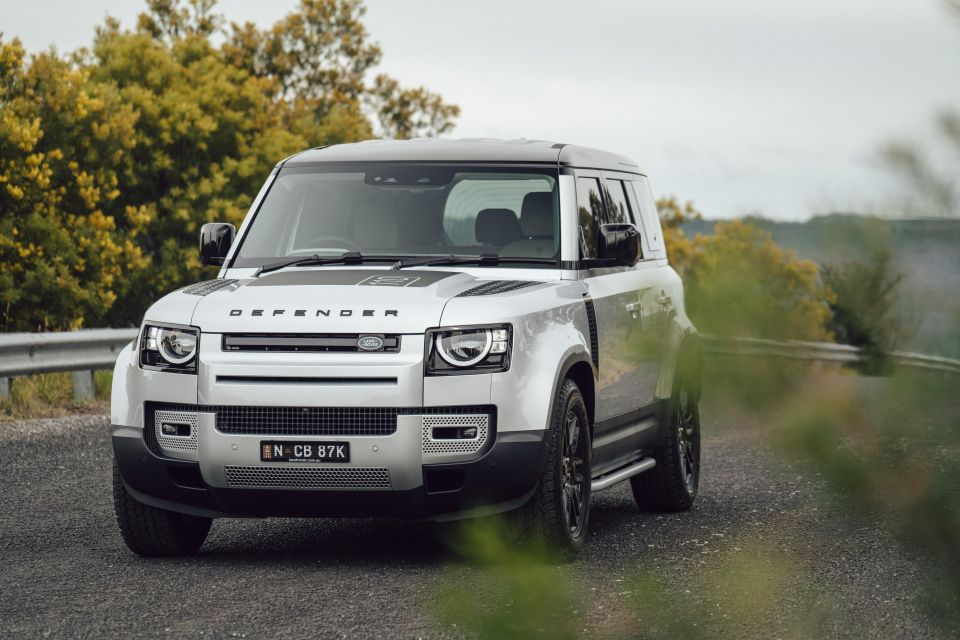

Rivals are hard to find, given the Defender’s combination of a premium badge and properly rugged off-road credentials. If it’s off-roading you want, the most expensive Jeep Wrangler is priced from $70,950 before on-road costs but comfort-wise it’s not in the same league.
If it’s premium you want, the BMW X5 kicks off at $102,900 before on-road costs. Although Mercedes-Benz has a natural competitor in the G350d, the only G-Wagen offered in Australia is the G63 AMG and it’s priced from $259,600 before on-road costs.
Buy your new car without the stress. It's fast, simple and completely free.

Great service from Travis and team, second time I have used this business would not hesitate to recommend them to anyone
Craig C.
Purchased a Ford Ranger in Sunshine Coast, QLD
CarExpert helped Craig save thousands on his Ford Ranger, now let us save you on your next new car.
Find a dealDepends on how much you’re willing to spend. Every Defender rides on air suspension, and features adaptive dynamics and the latest configurable Terrain Response off-road system offering a choice between six different drive modes including Wade for the first time. When engaged, the system uses the air suspension to raise the ride height while closing the HVAC vents to reduce moisture entering the system.
LED headlights and tail lights and the Core exterior package are standard, along with 18-inch alloy wheels, a full-sized spare, partially-powered front seats, keyless entry and start, dual-zone climate control, a 10-inch touchscreen infotainment system, DAB+ radio, and Apple CarPlay and Android Auto smartphone mirroring.
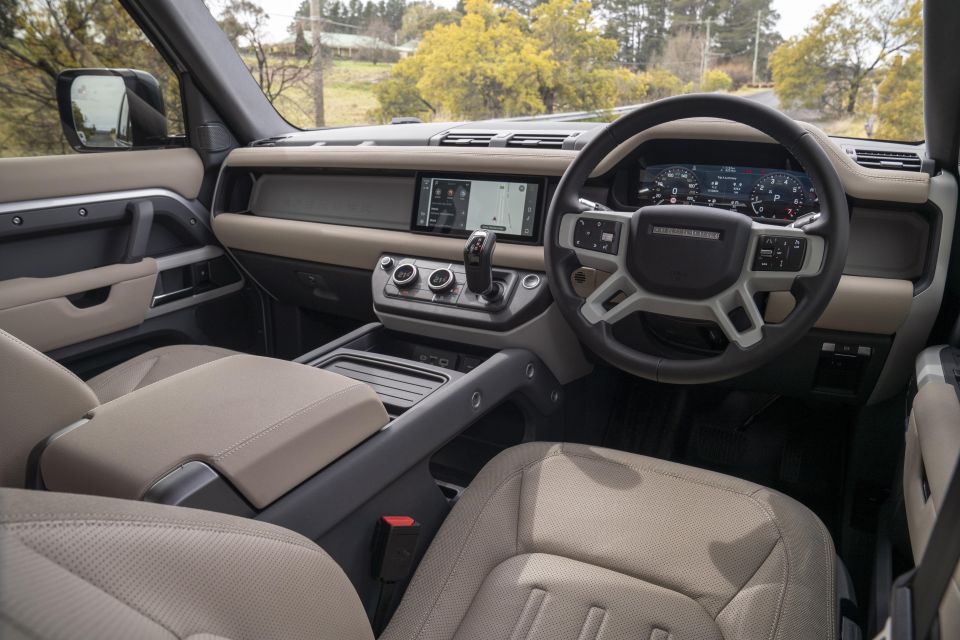
Defender also gets Jaguar Land Rover’s latest and fastest Pivi Pro software as part of the next-generation infotainment system. The system uses a super-fast processor for instant touchscreen responses with a 1920 x 720 colour resolution. You’ll notice the speed of the system on start-up, especially.
The S specification gains a leather gearshift gaiter, auto high-beam, 12-way partially powered front seats, a folding central rear armrest, a leather-wrapped steering wheel, a centre console with armrest, and digital instruments.
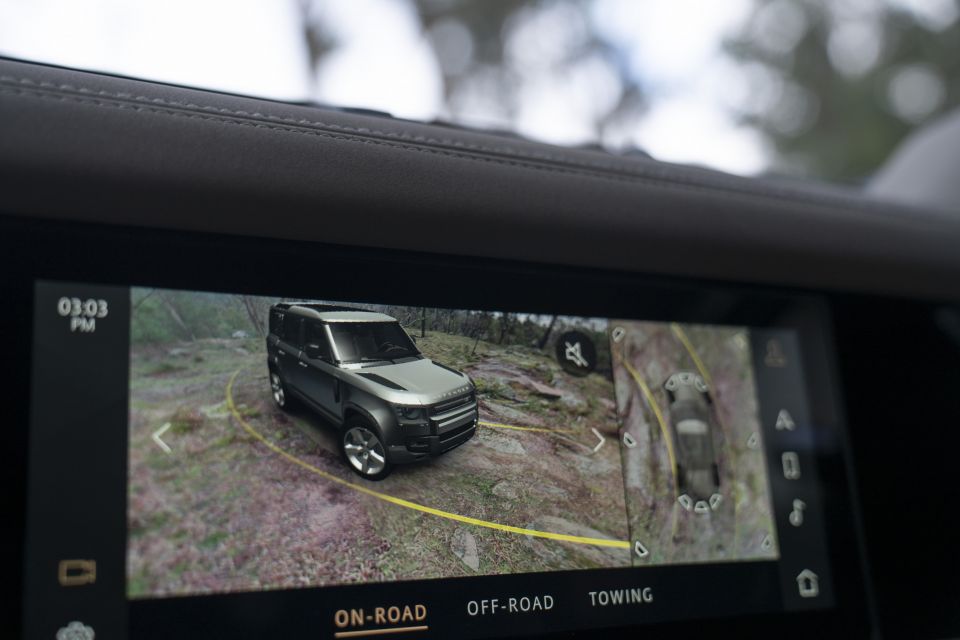
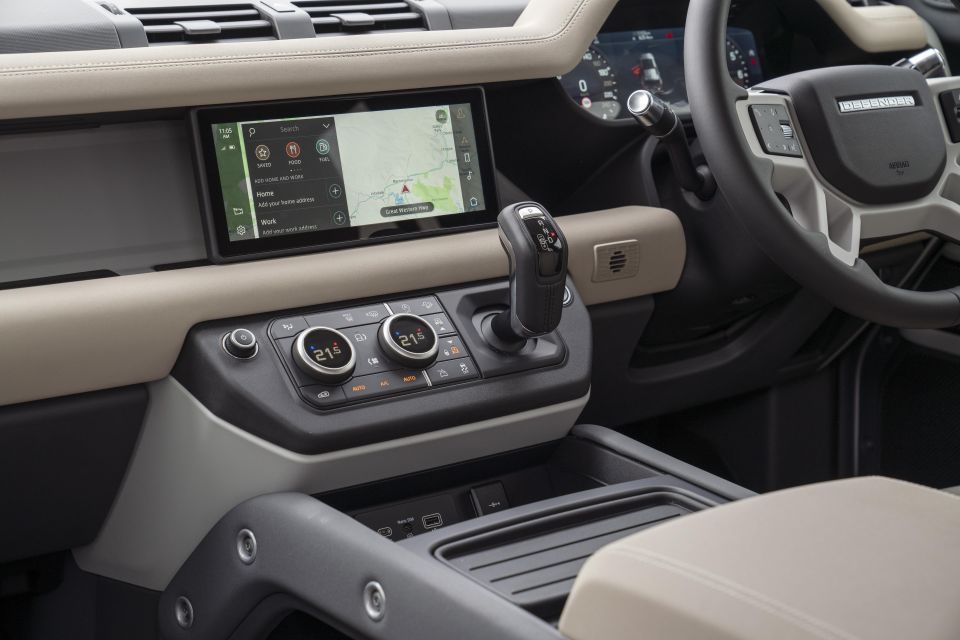

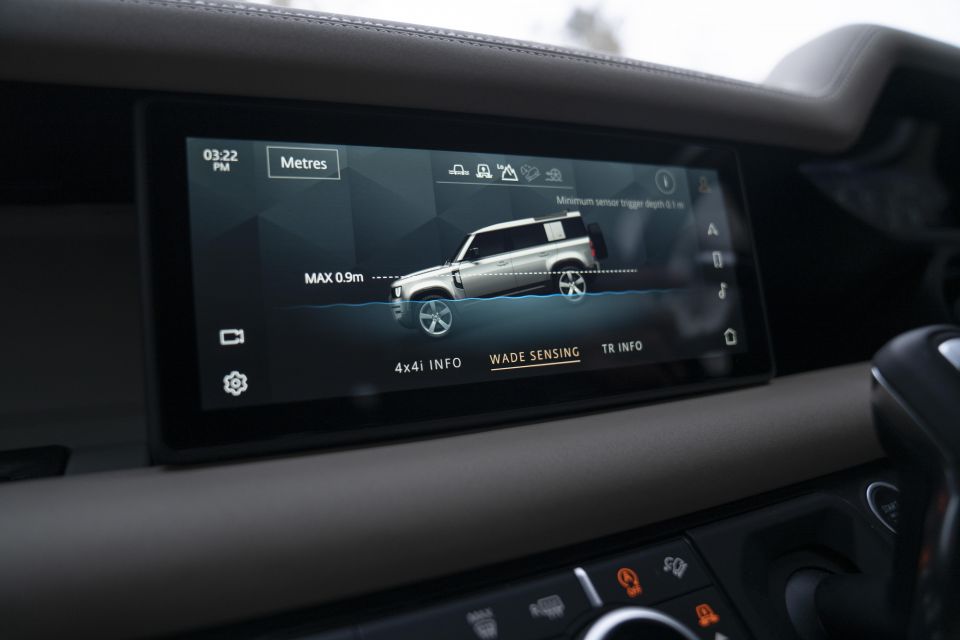
The SE gains front fog lights, premium LED headlights with signature daytime running lights, 20-inch alloy wheels, 12-way fully-powered front seats, electric steering column, digital rear-view mirror, a Meridian sound system, blind-spot monitoring, rear cross-traffic alert, and the clear-exit monitor.
Finally, the range-topping HSE packs a sliding panoramic roof, matrix LED headlights, 20-inch alloy wheels in gloss dark grey, 14-way heated and cooled front seats, carpet mats, a full-leather steering wheel, extended leather trim, adaptive cruise, and a rear collision monitor.
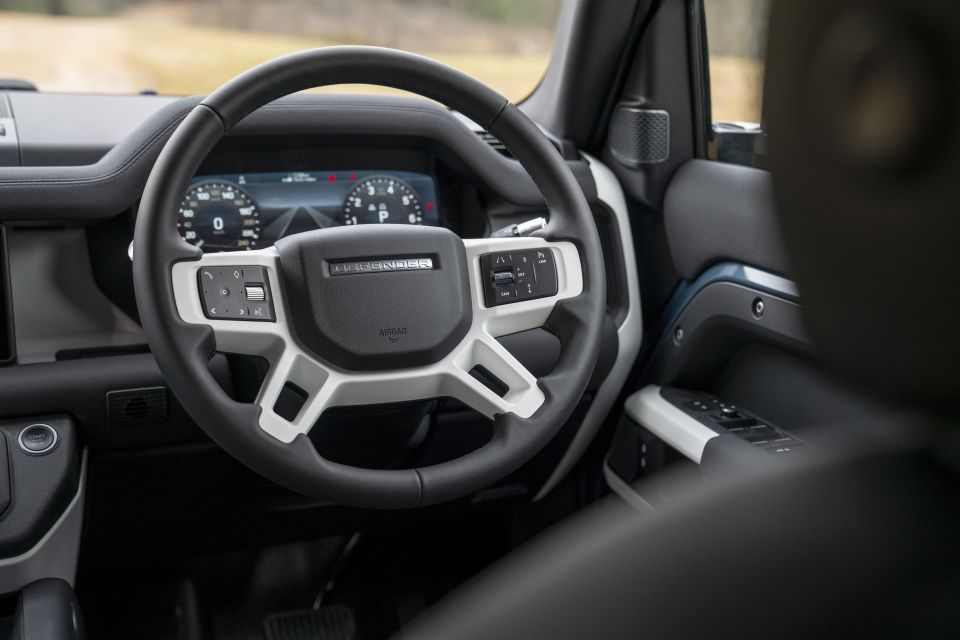
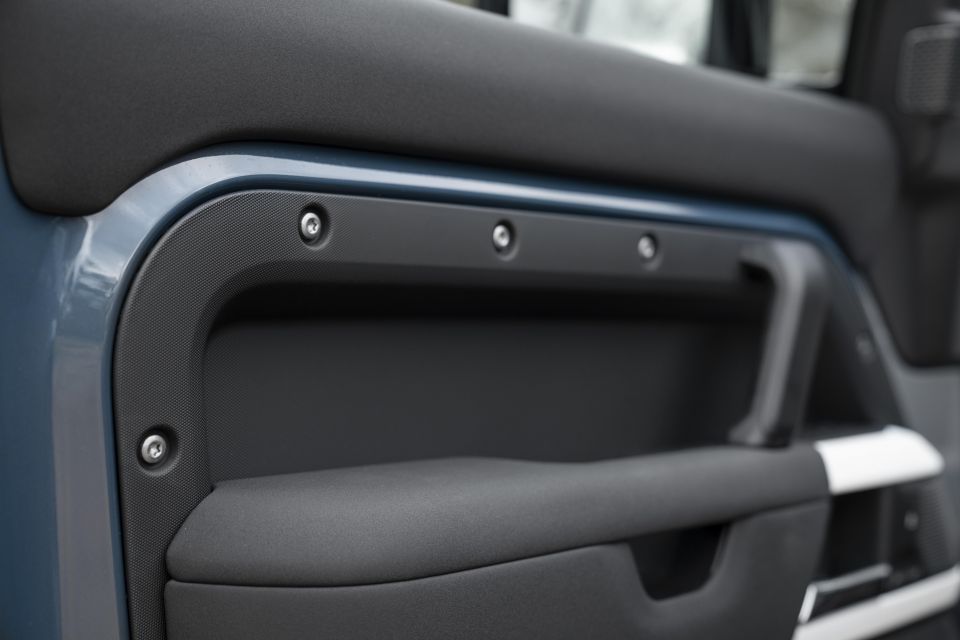

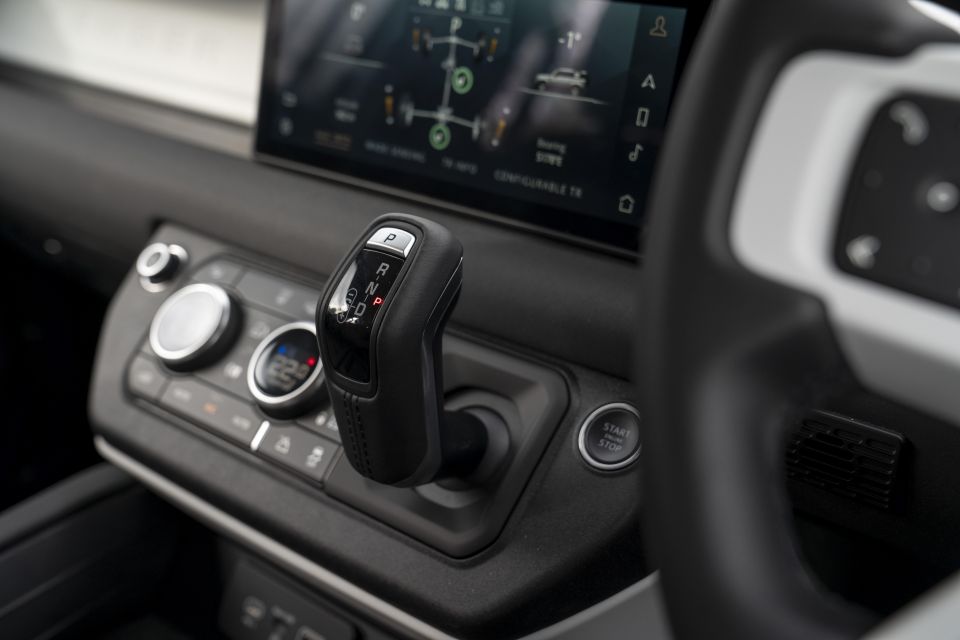
ANCAP and Euro NCAP are yet to give the new Land Rover Defender a safety rating.
Regardless, all versions of the Defender come as standard with autonomous emergency braking (AEB), a surround camera system, cruise control with speed limiter, driver condition monitor, lane-keeping assist, parking sensors all round, and traffic sign recognition.
The Defender also comes equipped with front airbags (with passenger seat occupant sensor), tyre pressure monitoring, seatbelt reminders, and ISOFIX mounts for the two outboard rear seats.
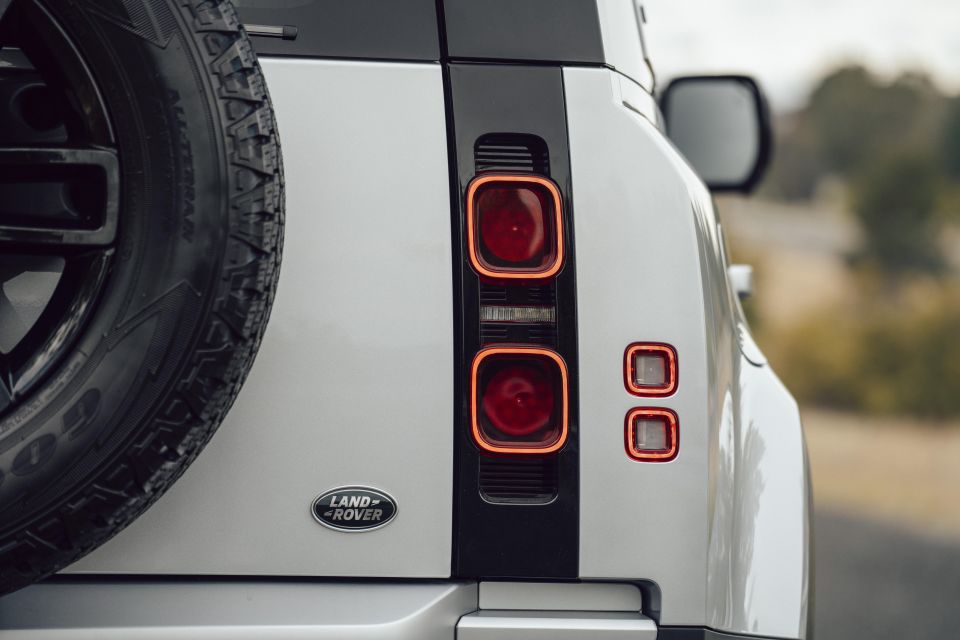
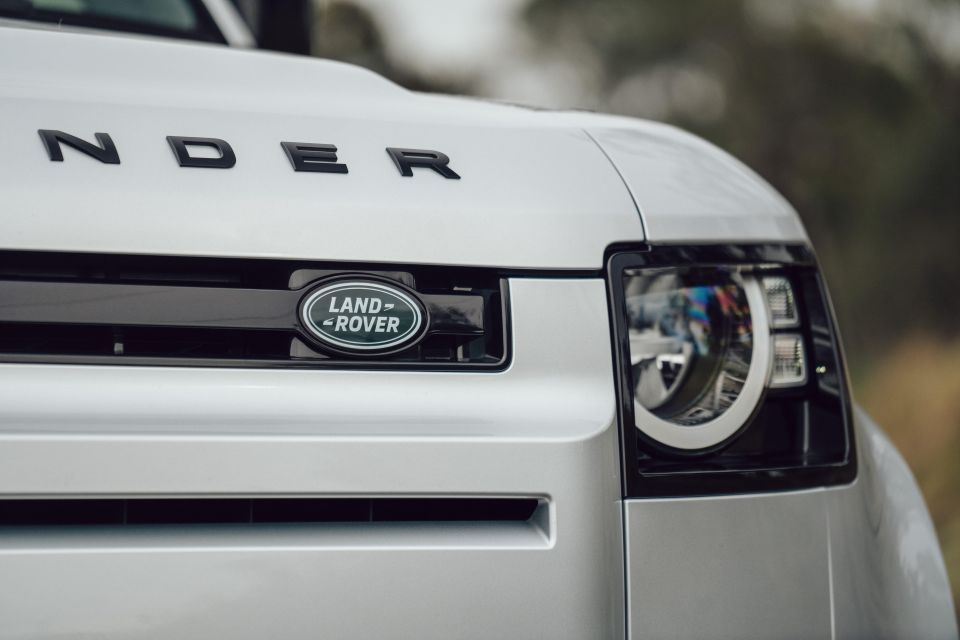

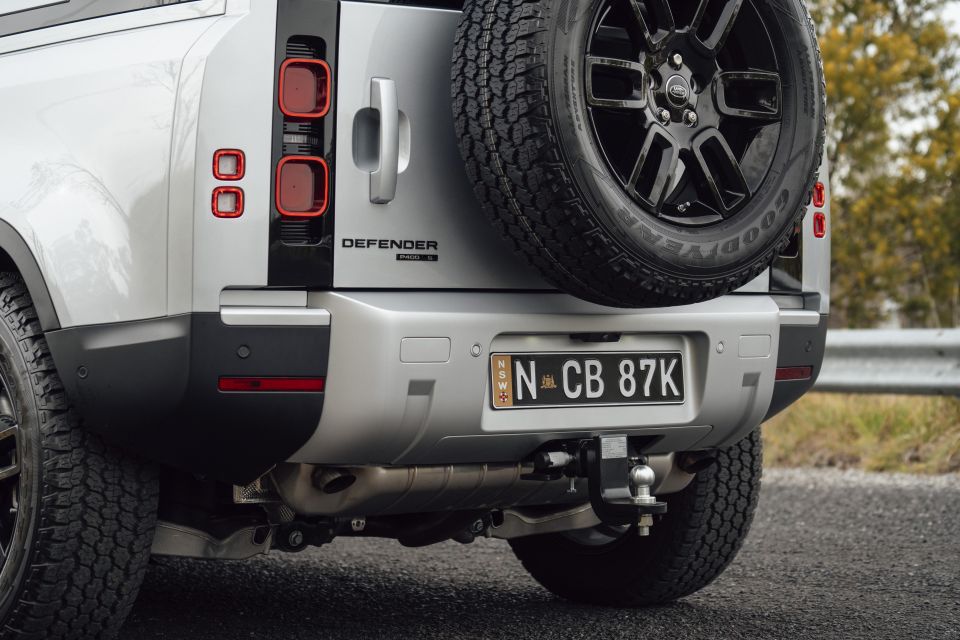
We only ever got to drive the relatively low-rung Defender S model at the launch event, but if this is a lower-rent version, I guarantee you’re going to be more than satisfied. Just don’t look at the features you’re missing out on with the SE trim.
The entire layout of the cockpit is both minimalist and contemporary at the same time. The dash-mounted shifter feels aviation-inspired, and is intuitive and nice in the hands. There are no traditional buttons or switches, everything is touch and perfectly logical.
I particularly like the driver’s digital instrument display. It’s large and clear, while blending traditional binnacles with the digital readouts. Big fan.

Where expert car reviews meet expert car buying – CarExpert gives you trusted advice, personalised service and real savings on your next new car.
The seats (front and rear) are superbly comfortable and feature a mixture of grained leather and a highly durable textile in the harder-wearing sections. They also provide very good levels of cushioning and lateral bolster, as I would discover on the road loop.
The focus seems to be on long-term durability, including the floor which is rubberised with flush sills so that you can mop it out after excursions off-road or even to the beach. Finally, the middle seat passenger won’t have to suffer as the second-row floor is flat.
Buyers can specify an optional front jump seat ($1853), which allows three people to travel in the front row. It means the Defender 110 can be specified with five, six, or 5+2 seating.
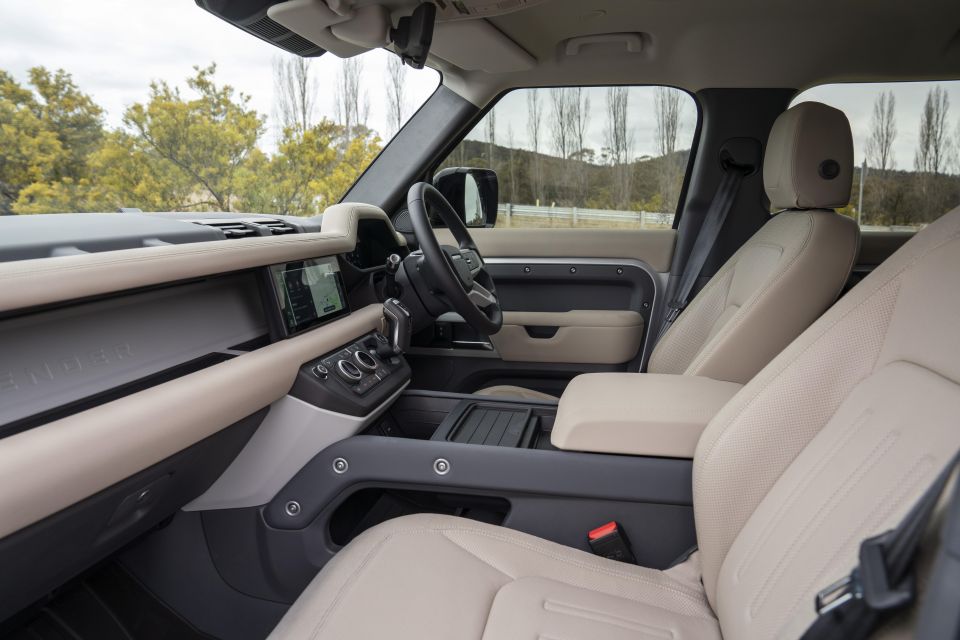
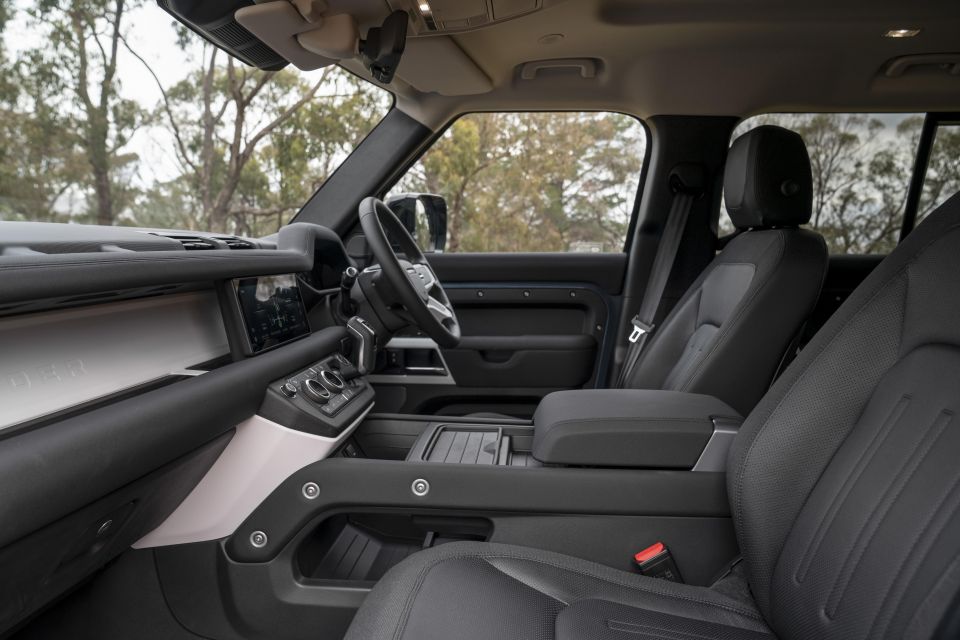
I’ve already mentioned the exposed fixings throughout the Defender, but the cabin also features padded waist rails, grab handles, and arm rests if the going gets rough.
Clever storage solutions are everywhere throughout the cabin, some of which will swallow larger-than-usual items. There’s no shortage of charge ports, and that’s USB, USB-C, and 12V across both rows.
Moreover, all Defenders boast a lockable 5.8L glovebox and extra-deep door pockets. And the crossbeam I mentioned earlier doubles as a parcel shelf, providing another 6.9L of storage for bits and pieces.
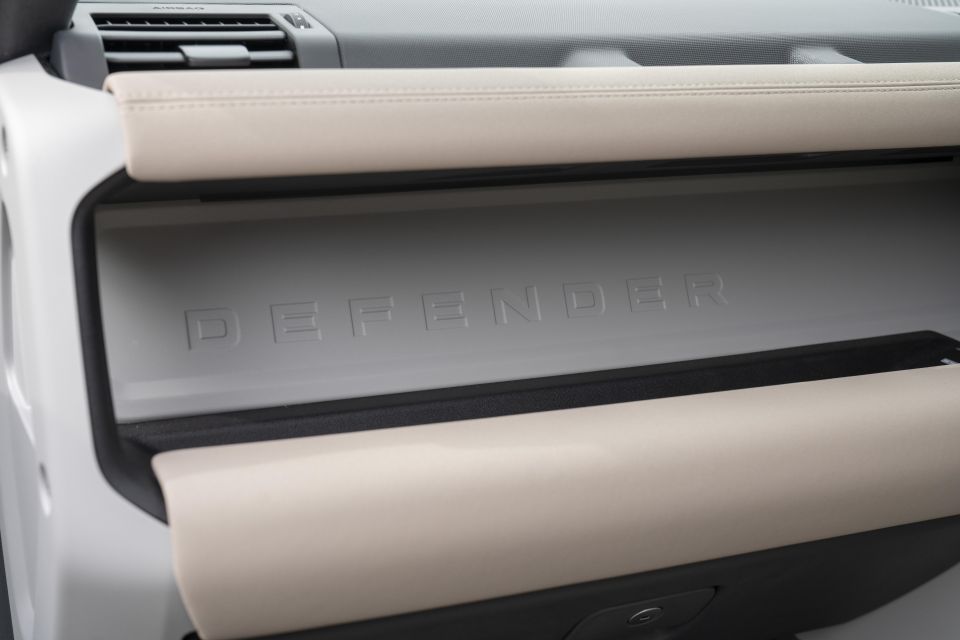
Luggage or outdoor gear storage is superbly catered for with up to 646 litres of boot space behind row two, or 231 litres behind row three if you spec the 5+2 configuration. If you load kit to the roof, you’ll pack 1075 litres behind the second row.
Fold the rear seats flat and load space opens up to 2380 litres, but that’s to the roofline.
The sole petrol option in Australia currently is the P400, which features a 3.0-litre turbocharged inline six with 48V mild-hybrid technology, making 294kW and 550Nm.
All Defender models come fitted as standard with an eight-speed automatic with high-and low-range transfer box.

Fuel economy is rated at rated at 9.9L/100km and 230g/km of CO2 on the combined cycle and we came very close to that despite a rather enthusiastic road loop. More on that below.
First off, if you’ve ever owned a Land Rover product (even if you haven’t) you’re going to feel at home behind the wheel of the new Defender. It’s called the Command driving position, and despite the elevated ride height you feel like you’re sitting deep in the vehicle, rather than perched on top.
After a short road section to the start of a proper 30km off-road course it was time for put the new Defender through its paces. There’s no Terrain Response dial, it’s just a matter of pushing a button near the shifter and using the right-hand HVAC dial to scroll through to your chosen off-road program.
What was immediately noticeable before we hit the mud ruts or steep rock climbs was the ridiculously good ride comfort. Forget gravel, you don’t feel it. I mean, you might as well be cruising along on tarmac, such is the way this air suspension system utterly neutralises rough ground.

Next up were trails littered with muddy ruts, 30cm or more deep and quite soft. Low range is another button away while in neutral. It’s that simple. The sublime ride comfort is somehow maintained, and there’s little or none of the usual squirming of a 2.3-tonne beast. It just tracks straight and steady without so much as a hitch.
No more than 20 minutes in I’m already thinking along the lines, ‘It’s too good to be true’. Things in the bush only got better as we pushed harder in more challenging terrain. It takes seconds to switch from one mode to another, or from low-range to high.
Steep rock climbs with deep ruts up may as well have not been there. This was all starting to feel a bit too easy, so I picked out the steepest route next time round. Still, the Defender wasn’t fazed.
There’s real genius in the engineering, or the Goodyear Wrangler DuraTrac tyres are simply remarkable. A bit of both, I suspect.

In the end, I just increased the speed of the Defender on the trail given the ease of its progress, parts of which I would have labelled as hardcore in any other vehicle.
Arriving back at base near Marrangaroo in NSW, we jumped into another P400 S Defender shod with Goodyear Wrangler 255/65 R19 tyres with a stronger road bias.
Again, the ride compliance jumped out first and foremost. I shoved the shifter over to manual and got on the the throttle with clear road ahead. I can’t give you the route, but these are some glorious driving roads – with plenty of nicely cambered bends – some with tightening radii and others fast-flowing over undulating terrain.

I’ve had some previous experience with the P400 i6 petrol engine in the Range Rover and, while it was surprisingly sporty in that vehicle, I wasn’t expecting the same level of satisfaction in a bloody Defender.
But body control is outstanding. I mean, there must be decent chassis roll going on under me, but it’s not something I’m conscious of.
I’m giving it some proper curry and not holding back, and it’s holding its line. I know, because the guy in front has got the same idea. I’m watching his line through the tighter bends and it just grips and hammers onto the next corner. It’s truly remarkable stuff, and something no-one will be expecting, least of all me.
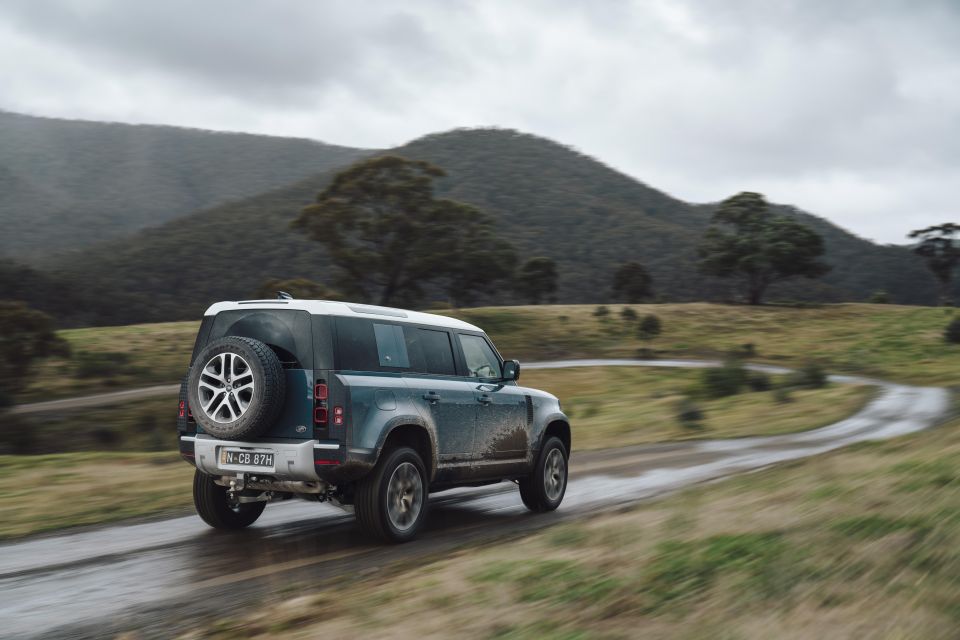
After clocking up around 130 kilometres of thoroughly enjoyable road driving the average fuel consumption read 13.7L/100km. I had to look twice at the figure, I can assure you.
Maintenance in the Land Rover Defender is priced at $1950 for five years in diesel models, or $2650 in the P400 on test here.
The Land Rover line-up is covered by a standard three-year, 100,000km new vehicle warranty in Australia.

However, the Defender is launching with a five-year, unlimited-kilometre warranty, and Land Rover has indicated it doesn’t plan to move back to its three-year warranty.
Make no mistake, the second-generation Land Rover Defender is a bona-fide game changer for the entire segment. McGovern and the engineers have created an automotive masterpiece, seemingly without flaw. Its ability off-road, while providing a genuinely luxurious ride is simply unparalleled in my book.
I’m not sure what to say about its ability to carve up the twisties in the same way I might drive a hot hatch, other than I remain in awe. Only the guy in front and behind will believe me.
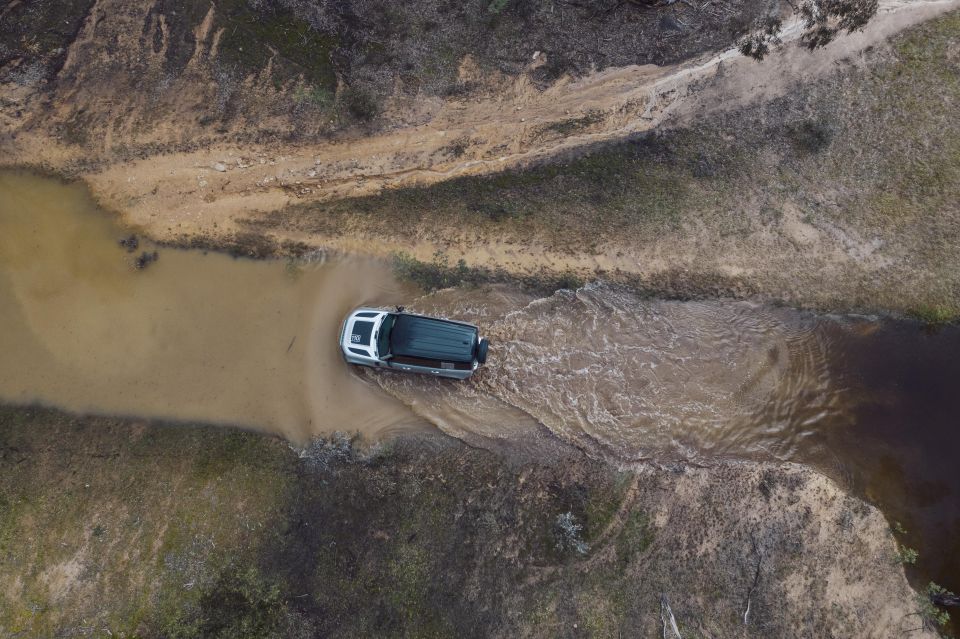
It makes me think about what might happen with the Discovery, because the Defender surely outperforms it in every measure and that’s before we get into the design itself. At least, that’s the P400. The diesel models are yet to be tested and may prove less exciting.
Where expert car reviews meet expert car buying – CarExpert gives you trusted advice, personalised service and real savings on your next new car.
Anthony Crawford is a CarExpert co-founder and senior presenter with 20+years in automotive journalism and content creation.


CarExpert.com.au
4 Days Ago


Damion Smy
5 Days Ago


Damion Smy
5 Days Ago


Josh Nevett
5 Days Ago


Max Davies
5 Days Ago


Ben Zachariah
6 Days Ago